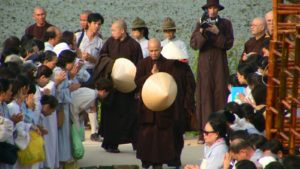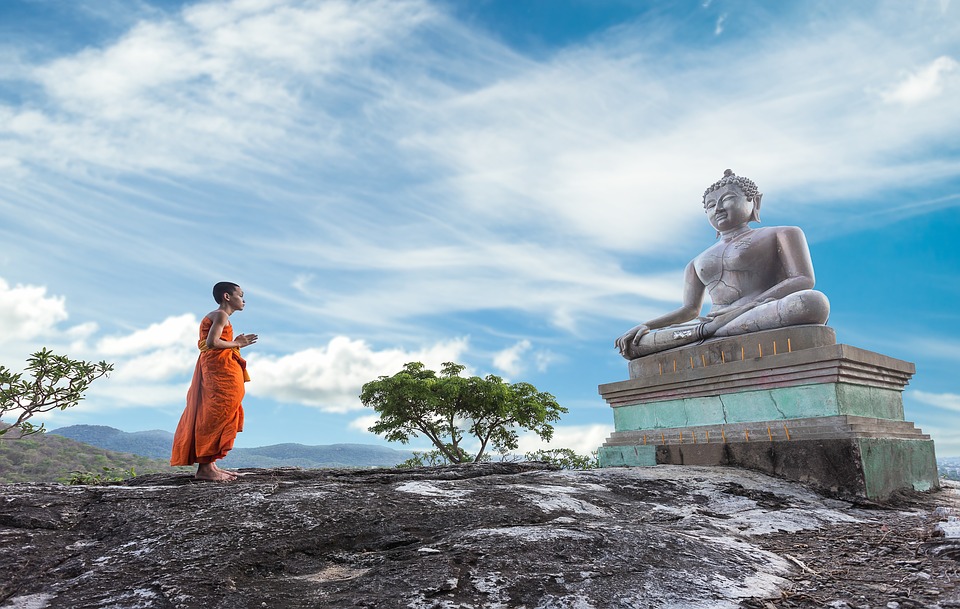We often talk about the path of non-attachment a central concept found in the Perennialist teachings of Buddha Sakyamuni and Rav Yeshua (Jesus the Nazarene). In order to actually release our attachments, it is helpful to understand what causes them.
In general terms, attachment arises from grasping. There are four types of grasping: grasping after opinion, grasping after sensory pleasure, grasping after rule and rite, and grasping after the theory of “self”. In even more general terms, we can say that grasping after those things we imagine to bring us happiness and grasping to avoid those things we perceive as causing us pain are the foundational conditions, which give rise to attachments.
Grasping After Opinion
How many times have we found ourselves at odds with someone or some group, because they differ strongly in opinion from us?
Now I am not suggesting that having a personal opinion, even a strong personal opinion, is wrong. In fact, I believe that our opinions add to the experience of personal growth and development. But we must guard ourselves against becoming attached to them.
When we recognize an opinion as an opinion, it’s difficult to be attached, because we see that thought or idea as a perception based observation. In a world that is not static, our perception is bound to shift and change, and as it does, our opinions (should) change as well.
Some years back, while I was still serving as the exarch and metropolitan archbishop of the autocephalous Franciscan communities in North America, a transcript of my weekly sermon was published, in which I stated my personal and theological opinion that the traditions of “virgin birth” and “immaculate conception”, “stigmata” and “resurrection” were concepts that could not rationally be considered as literal fact, and were simply part of the cultural and religious mythos of a primitive mindset from which the institutional Church developed. One of the men I ordained to become bishop-protector of the Canadian Provinces a brilliant and well-educated, former Roman-Catholic priest was apparently of the opinion that such myths and legends, along with the Medieval and Tridentine prescriptions for liturgical prayer, ought to be considered as literal fact. He felt strongly enough about it to separate himself from our community, and start his own sect.
For some time, I am quite certain that he and his disciples (who were comprised of individuals we dismissed from our community for various reasons) allowed their opinions to engender feelings of disgust and disdain for me. But these were genuinely compassionate and kind people, most of whom are very well-educated and intelligent. They began to recognize that opinions are just that, and so there has remained a subtle undercurrent of compassion and loving-kindness there, even if it was not spoken of. And in the past few weeks, several of them, including that one particular bishop, has been in contact with me, expressing and demonstrating their concern and compassion, prayers and support during a time of difficult physical health challenges.
If there is someone with whom you have not spoken, because they “are stupid” or “don’t get it”, please consider the possibility that they simply perceive things from a different “angle” and that there is no “right” or “wrong” opinion.
Grasping After Sensory Pleasure
Human sexuality, listening to music, eating your favorite foods none of these things are, in and of themselves, “dangerous” or “bad”. But once again, if we imagine that our happiness will come from owning a certain CD, attending a specific concert, dining at our favorite Indian restaurant, or a night of unbridled passion with someone(s), then we are setting ourselves up for disappointment, and we are grasping.
 We must understand that everything we need for complete happiness already exists within us. Happiness is our nature, or as Joseph Smith noted, “is the object and design of our existence.” (Unfortunately, his followers missed that point entirely, and chose to spend tens of thousands of dollars diminishing the civil rights of others, so that their self-imposed religious values could be codified into law, under Prop 8).
We must understand that everything we need for complete happiness already exists within us. Happiness is our nature, or as Joseph Smith noted, “is the object and design of our existence.” (Unfortunately, his followers missed that point entirely, and chose to spend tens of thousands of dollars diminishing the civil rights of others, so that their self-imposed religious values could be codified into law, under Prop 8).
It is unnecessary to give any sexual activity, music, food, bubble bath or anything else up, if it gives you pleasure and harms no one. It is necessary, however, to be mindful. An occasional soak in a hot bath of warm Dead Sea salts can be healthful and invigorating. Spending $20-$30/month on spa treatments might be attachment however, particularly if we spent money that could have been used to help someone we know in need. It’s all about balance and awareness and knowing that nothing will bring us lasting happiness, except letting go of it all.
Grasping After Rule and Rite
Such dogmatic, theocratic, religious and doctrinal arguments that cause separation and marginalization are never useful. Many of those who regularly listen to my Dharma talks (or read my blogs) agree that such discriminatory measures as Proposition 8 are unspeakable injustices. But if I were to suggest that “any two or more adults ought to have the right to solemnise and legally bind their relationship, in any way they deem appropriate, with the same legal and civil protections, benefits, and status under law enjoyed by heterosexual couples today” some of those same folks (including the gay ones, who got married in Massachusetts or California) would balk. What makes it OK for any “two” people to marry, but wrong if three or four wish to do the same thing?
 A cursory look through my blog and there are countless examples of folks who don’t believe I have any right to call myself a Franciscan or Camaldolese monk, a Buddhist monastic or contemplative, or a spiritual leader. Why? Because their particular rule of life, religious ritual, constitution or theology does not allow for someone who teaches what I teach.
A cursory look through my blog and there are countless examples of folks who don’t believe I have any right to call myself a Franciscan or Camaldolese monk, a Buddhist monastic or contemplative, or a spiritual leader. Why? Because their particular rule of life, religious ritual, constitution or theology does not allow for someone who teaches what I teach.
Not only do I strive not to become attached to my own rule of life or any spiritual/religious ritual, but I also strive not to allow others’ grasping at theirs to disturb my peace.
Last week, one of the clergy from a very divisive and frankly peculiar religious sects that operate under the leadership of a self-proclaimed “paranormal expert” and “demon slayer/exorcist” (I could never make this shit up!) decided to wear his extravagant, thousand-dollar episcopal “choir” vestments as an Hallowe’en costume. Now I find spending such absurd amounts of money one such item (like his $3,000 bishop’s crozier, which still isn’t paid for) disturbing because there are hungry people and poor folks, who could have benefited from that money instead. But if his rite and rule of life permit him to behave in such a manner, then it is of no concern to me. Yes, he is diminishing the credibility of clergy in his state and further illustrating the reasons his fellow “ghostbusters” have become the laughing stock of the independent Catholic movement but they are answerable to their own way of life, just as I am to mine.
Grasping for a Sense of “Self”
The words “I AM” are used in Judeo-Christian mythos as positive declarations of the Indwelling Presence of the Sacred in all of life. But in our daily lives, most times that we say “I am” we are investing in an illusion of permanence and separateness that is unhelpful.
Again, it’s all about our awareness. When we realize there is no “real” us versus them, that what the Great Teacher was really saying when we look at the Aramaic context of the words, is “I am ONE with the Way; I am ONE with the Truth, and I am ONE with Life”, then it is not problematic to make “I am” statements.
I can say “I am certain that”, but we must realize that everything we think, including the illusion of “selfhood” is based on a faulty, and ever-changing perception; therefore, we cannot become attached to our thoughts, our sense of self, or our “I am-ness” because tomorrow (or in the next breath) all of that can change.
Realizing these basic, foundational causes for attachment, we can begin to look for ways in which we may let go of at least one source of attachment each day and as we do, our suffering will diminish, and genuine happiness and peace will become part and parcel of who we are.
Namaste!





